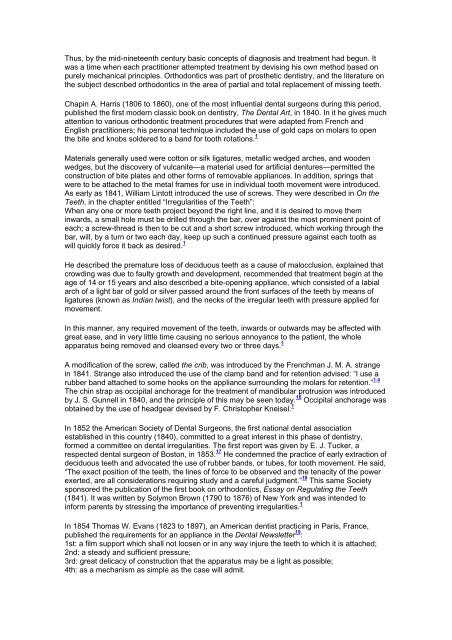A brief history of orthodontics - ortodontia e ortopedia facial
A brief history of orthodontics - ortodontia e ortopedia facial
A brief history of orthodontics - ortodontia e ortopedia facial
Create successful ePaper yourself
Turn your PDF publications into a flip-book with our unique Google optimized e-Paper software.
Thus, by the mid-nineteenth century basic concepts <strong>of</strong> diagnosis and treatment had begun. It<br />
was a time when each practitioner attempted treatment by devising his own method based on<br />
purely mechanical principles. Orthodontics was part <strong>of</strong> prosthetic dentistry, and the literature on<br />
the subject described <strong>orthodontics</strong> in the area <strong>of</strong> partial and total replacement <strong>of</strong> missing teeth.<br />
Chapin A. Harris (1806 to 1860), one <strong>of</strong> the most influential dental surgeons during this period,<br />
published the first modern classic book on dentistry, The Dental Art, in 1840. In it he gives much<br />
attention to various orthodontic treatment procedures that were adapted from French and<br />
English practitioners; his personal technique included the use <strong>of</strong> gold caps on molars to open<br />
the bite and knobs soldered to a band for tooth rotations. 1<br />
Materials generally used were cotton or silk ligatures, metallic wedged arches, and wooden<br />
wedges, but the discovery <strong>of</strong> vulcanite—a material used for artificial dentures—permitted the<br />
construction <strong>of</strong> bite plates and other forms <strong>of</strong> removable appliances. In addition, springs that<br />
were to be attached to the metal frames for use in individual tooth movement were introduced.<br />
As early as 1841, William Lintott introduced the use <strong>of</strong> screws. They were described in On the<br />
Teeth, in the chapter entitled “Irregularities <strong>of</strong> the Teeth”:<br />
When any one or more teeth project beyond the right line, and it is desired to move them<br />
inwards, a small hole must be drilled through the bar, over against the most prominent point <strong>of</strong><br />
each; a screw-thread is then to be cut and a short screw introduced, which working through the<br />
bar, will, by a turn or two each day, keep up such a continued pressure against each tooth as<br />
will quickly force it back as desired. 1<br />
He described the premature loss <strong>of</strong> deciduous teeth as a cause <strong>of</strong> malocclusion, explained that<br />
crowding was due to faulty growth and development, recommended that treatment begin at the<br />
age <strong>of</strong> 14 or 15 years and also described a bite-opening appliance, which consisted <strong>of</strong> a labial<br />
arch <strong>of</strong> a light bar <strong>of</strong> gold or silver passed around the front surfaces <strong>of</strong> the teeth by means <strong>of</strong><br />
ligatures (known as Indian twist), and the necks <strong>of</strong> the irregular teeth with pressure applied for<br />
movement.<br />
In this manner, any required movement <strong>of</strong> the teeth, inwards or outwards may be affected with<br />
great ease, and in very little time causing no serious annoyance to the patient, the whole<br />
apparatus being removed and cleansed every two or three days. 1<br />
A modification <strong>of</strong> the screw, called the crib, was introduced by the Frenchman J. M. A. strange<br />
in 1841. Strange also introduced the use <strong>of</strong> the clamp band and for retention advised: “I use a<br />
rubber band attached to some hooks on the appliance surrounding the molars for retention.” 1,4<br />
The chin strap as occipital anchorage for the treatment <strong>of</strong> mandibular protrusion was introduced<br />
by J. S. Gunnell in 1840, and the principle <strong>of</strong> this may be seen today. 16 Occipital anchorage was<br />
obtained by the use <strong>of</strong> headgear devised by F. Christopher Kneisel. 1<br />
In 1852 the American Society <strong>of</strong> Dental Surgeons, the first national dental association<br />
established in this country (1840), committed to a great interest in this phase <strong>of</strong> dentistry,<br />
formed a committee on dental irregularities. The first report was given by E. J. Tucker, a<br />
respected dental surgeon <strong>of</strong> Boston, in 1853. 17 He condemned the practice <strong>of</strong> early extraction <strong>of</strong><br />
deciduous teeth and advocated the use <strong>of</strong> rubber bands, or tubes, for tooth movement. He said,<br />
“The exact position <strong>of</strong> the teeth, the lines <strong>of</strong> force to be observed and the tenacity <strong>of</strong> the power<br />
exerted, are all considerations requiring study and a careful judgment.” 18 This same Society<br />
sponsored the publication <strong>of</strong> the first book on <strong>orthodontics</strong>, Essay on Regulating the Teeth<br />
(1841). It was written by Solymon Brown (1790 to 1876) <strong>of</strong> New York and was intended to<br />
inform parents by stressing the importance <strong>of</strong> preventing irregularities. 1<br />
In 1854 Thomas W. Evans (1823 to 1897), an American dentist practicing in Paris, France,<br />
published the requirements for an appliance in the Dental Newsletter 19 :<br />
1st: a film support which shall not loosen or in any way injure the teeth to which it is attached;<br />
2nd: a steady and sufficient pressure;<br />
3rd: great delicacy <strong>of</strong> construction that the apparatus may be a light as possible;<br />
4th: as a mechanism as simple as the case will admit.


